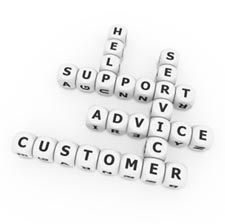
Social media is one of those “a lot of things to a lot of people” type of thing. To one person, it’s a way to keep up with their friends. For another, keeping up with trends. -And for some, it’s a way of getting a hold of a company when things go bad, or making sure everybody knows you’re unhappy because that company didn’t respond.
Social Customer Relations – Benefits and Risks
One use of social media for your business is for handling customer relations. This may be your primary point of contact or an alternative channel. In either case, it’s important to ensure that the image presented is professional, fair and consistent.
Remember, you’re not just dealing with existing customers, you’re also demonstrating to all the bystanders how they can expect to be dealt with if they do business with your brand. Customers can be very loyal to a brand they trust – but trust can be lost very quickly.
There’s an important difference to remember when you’re deliberately using social media to interact with your customers in this way. To the user, your social account becomes more of an official representation. It becomes a more “official” representation, in the perception of users.
While comments made in a less official social venue can reflect upon the company (sometimes in a good way, sometimes not so good), once you make a soc
ial media platform an accepted channel for business issues, you have to be extremely aware of what you say in that venue. People will see it in the same light they would view something on your company’s website.
Avoid Social Media Platform Disasters

Here are a few tips on how to avoid the potential for disaster when your social media account is your primary customer relations platform:
- Procedures and Policies Manual – Have a comprehensive manual, defining how different types of issues should be responded to, such as complaints:
- If a customer complains that an order hasn’t arrived, for instance, what should be the response?
- Provide a service email address for them to send you the order number and any other pertinent information so you can investigate the issue.
- As soon as you receive the email, post that you’ve received it and that investigation is underway.
- When you have your findings, respond by email, but post that you’ve sent them an email of the results. This lets the bystanders see that you’re on top of things.
- Once you’ve resolved the issue, if others ask what the results were and it was the fault of the company, admit it and tell what you did to make it right (going the extra mile when it’s the company’s fault is always a good idea. Including a freebie, reimbursing a portion – or even all – of the cost is a goodwill gesture that can build your brand’s trust!) If the complaint was determined to be unwarranted or false, simply say that the issue was resolved privately with the complainant. If he wants to make it public, that’s his call. Regardless, let everyone know that the issue has been resolved.
- The cardinal rule: EVERY customer deserves a courteous and prompt response. If they get abusive, do NOT respond in kind, and do NOT delete their comments just because they’re negative (vulgar, racist, threatening or abusive comments are different – report and hide them). Be professional and courteous, regardless.
- Your manual should clearly state your escalation policy – ie: what sort of situation should warrant the immediate notification of a supervisor or manager. Even though a company might be relatively small, the impact of the owner or a senior manager getting personally and visibly involved in any complaint, even if only after a satisfactory resolution, can build tremendous goodwill, both with an irate customer and with bystanders.
- Attitude and Personality
- Your manual should also identify the sort of personality and attitude to be projected in postings. Funny, friendly, strictly professional, etc…. this is something that should be considered early on and clearly indicated in your manual.
- The customer may not always be right, but it’s a good practice to show that you assume they are (until evidence proves otherwise). This attitude will show and will build trust, too.
- If you decide to make Facebook or some similar platform your semi-official go-to spot for customer relations, you need to keep it on the same level you would if it was located in your offices. Information should be easy to find, access and understand, and you should have notifications set so that you can respond quickly to any inquiry. I would also suggest you post prominently the hours during which the page is most closely monitored.
If you treat your social desk as you would your office lobby, and handle their questions and concerns professionally and pleasantly, you’ll find that you can build trust and credibility quickly. Just be aware that trust can be lost quickly with a single misstep, too.